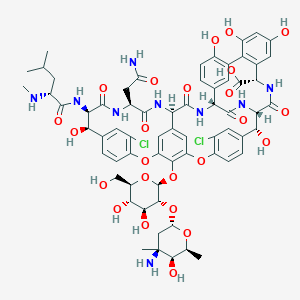| 1 |
ClinicalTrials.gov (NCT02466698) Intestinal Lavage for the Treatment of Severe C. Difficile Infections
|
| 2 |
Vancomycin FDA Label
|
| 3 |
Drugs@FDA. U.S. Food and Drug Administration. U.S. Department of Health & Human Services. 2015
|
| 4 |
The ChEMBL database in 2017. Nucleic Acids Res. 2017 Jan 4;45(D1):D945-D954.
|
| 5 |
Metronidazole FDA Label
|
| 6 |
FDA Approved Drug Products from FDA Official Website. 2009. Application Number: (NDA) 018517.
|
| 7 |
ClinicalTrials.gov (NCT00509639) Evaluation of Topical 10% Metronidazole Ointment for the Treatment of Active Perianal Crohn's Disease. U.S. National Institutes of Health.
|
| 8 |
Clinical pipeline report, company report or official report of the Pharmaceutical Research and Manufacturers of America (PhRMA)
|
| 9 |
Genetics and mechanisms of glycopeptide resistance in enterococci. Antimicrob Agents Chemother. 1993 Aug;37(8):1563-71.
|
| 10 |
Sequence of the vanC gene of Enterococcus gallinarum BM4174 encoding a D-alanine:D-alanine ligase-related protein necessary for vancomycin resistance. Gene. 1992 Mar 1;112(1):53-8.
|
| 11 |
vanG element insertions within a conserved chromosomal site conferring vancomycin resistance to Streptococcus agalactiae and Streptococcus anginosus. mBio. 2014 Jul 22;5(4):e01386-14.
|
| 12 |
Bacterial resistance to vancomycin: overproduction, purification, and characterization of VanC2 from Enterococcus casseliflavus as a D-Ala-D-Ser ligase. Proc Natl Acad Sci U S A. 1997 Sep 16;94(19):10040-4.
|
| 13 |
vanI: a novel D-Ala-D-Lac vancomycin resistance gene cluster found in Desulfitobacterium hafniense. Microb Biotechnol. 2014 Sep;7(5):456-66.
|
| 14 |
Emergence of high-level resistance to glycopeptides in Enterococcus gallinarum and Enterococcus casseliflavus. Antimicrob Agents Chemother. 1994 Jul;38(7):1675-7.
|
| 15 |
vanA in Enterococcus faecium, Enterococcus faecalis, and Enterococcus casseliflavus detected in French cattle. Foodborne Pathog Dis. 2009 Nov;6(9):1107-11.
|
| 16 |
Systems pharmacological analysis of drugs inducing stevens-johnson syndrome and toxic epidermal necrolysis. Chem Res Toxicol. 2015 May 18;28(5):927-34. doi: 10.1021/tx5005248. Epub 2015 Apr 3.
|
| 17 |
[Successful treatment of MRSA-associated glomerulonephritis with antibiotic therapy]. Nihon Jinzo Gakkai Shi. 2003;45(1):37-41.
|
| 18 |
DNA breakage due to metronidazole treatment. Mutat Res. 2001 Jul 1;478(1-2):153-8.
|
| 19 |
Does metronidazole interact with CYP3A substrates by inhibiting their metabolism through this metabolic pathway? Or should other mechanisms be considered? Ann Pharmacother. 2007 Apr;41(4):653-8.
|
| 20 |
Drug-drug interactions for UDP-glucuronosyltransferase substrates: a pharmacokinetic explanation for typically observed low exposure (AUCi/AUC) ratios. Drug Metab Dispos. 2004 Nov;32(11):1201-8.
|
| 21 |
The role of human cytochrome P450 enzymes in the formation of 2-hydroxymetronidazole: CYP2A6 is the high affinity (low Km) catalyst. Drug Metab Dispos. 2013 Sep;41(9):1686-94.
|
| 22 |
Summary of information on human CYP enzymes: human P450 metabolism data. Drug Metab Rev. 2002 Feb-May;34(1-2):83-448.
|
| 23 |
Giardia, Entamoeba, and Trichomonas enzymes activate metronidazole (nitroreductases) and inactivate metronidazole (nitroimidazole reductases). Antimicrob Agents Chemother. 2009 Feb;53(2):458-64.
|
| 24 |
Acetamide--a metabolite of metronidazole formed by the intestinal flora. Biochem Pharmacol. 1979 Dec 15;28(24):3611-5.
|
| 25 |
Overexpression, isotopic labeling, and spectral characterization of Enterobacter cloacae nitroreductase. Protein Expr Purif. 1998 Jun;13(1):53-60.
|
| 26 |
Mechanism of metronidazole-resistance by isolates of nitroreductase-producing Enterococcus gallinarum and Enterococcus casseliflavus from the human intestinal tract. FEMS Microbiol Lett. 2003 Aug 29;225(2):195-200.
|
| 27 |
Isolation of metronidazole-resistant Bacteroides fragilis carrying the nimA nitroreductase gene from a patient in Washington State. J Clin Microbiol. 2004 Sep;42(9):4127-9. Case Reports
|
| 28 |
An in vitro coculture system of human peripheral blood mononuclear cells with hepatocellular carcinoma-derived cells for predicting drug-induced liver injury. Arch Toxicol. 2021 Jan;95(1):149-168. doi: 10.1007/s00204-020-02882-4. Epub 2020 Aug 20.
|
|
|
|
|
|
|


